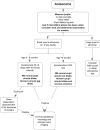Atypical Horner's syndrome: frequency, features and aetiology in a paediatric population
- PMID: 32424330
- PMCID: PMC8027383
- DOI: 10.1038/s41433-020-0967-0
Atypical Horner's syndrome: frequency, features and aetiology in a paediatric population
Abstract
Background/objectives: Paediatric Horner's syndrome (HS) may present atypically with incomplete or intermittent clinical features, yet could represent sinister pathology including neuroblastoma. We aim to report the frequency and features with which atypical HS presents in our population (Northern Ireland) and to propose an investigation algorithm to aid diagnosis in these challenging cases.
Subjects/methods: Retrospective chart review of all paediatric anisocoria and HS cases presenting to Belfast, Northern Ireland, between 2012 and 2018, identified through searching our paediatric ophthalmology database.
Results: Sixty-one eligible cases of anisocoria or HS were analysed. Ten cases of HS were identified, four (40%) of which presented atypically with incomplete or intermittent features. Two of these four atypical cases were secondary to neuroblastoma. Overall incidence of paediatric HS in Northern Ireland during the study period was at least 2.54 per 100,000.
Conclusions: Paediatric HS may present atypically in a significant number of cases. Accordingly, clinicians should consider HS in children with a history of anisocoria or ptosis and have a low threshold for use of pharmacological tests to aid diagnosis.
Conflict of interest statement
The authors declare that they have no conflict of interest.
Figures




References
-
- Northern Ireland Statistics and Research Agency. 2016 Mid year population estimates for Northern Ireland. 2018. www.nisra.gov.uk.
MeSH terms
LinkOut - more resources
Full Text Sources

